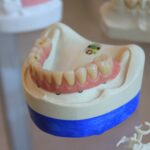
Alternatives to Dental Implants
May 7, 2019
Pros and Cons of Flexible Partial Dentures
June 29, 2020
may 7 • 3 MIN READ • MATTHEWS SMILES
Dental Occlusion
What is a Normal Dental Occlusion?

To put it simply, a dental occlusion is any contact made between the upper teeth and the lower teeth. This includes the movements made when chewing, resting, or grinding. Sometimes a dental occlusion is perfectly normal and safe, while other times, the occlusion can wear your teeth away at a dangerous pace. It’s important to know when an occlusion is healthy, and when you may want to look into braces to pull your teeth backward or forward. Here’s everything you need to know about a dental occlusion, and how you can determine whether you need to see a dentist about yours.
Overbites and Underbites

The two most concerning forms of occlusion are the overbite and the underbite. The overbite is when the upper jaw extends too far over the lower jaw. This can wear down on the teeth on the lower jaw and cause problems with the jaw. Jaw problems or misalignment could then lead to migraines, arthritis in the TMJ, jaw pain, speech impairments, and other serious occlusal problems. Those with overbites have jaws that appear tucked and the upper lip will seem to hang out further than the bottom lip. The misalignment will be over 3.5mm.
An underbite is nearly the opposite of an overbite. With an underbite, the teeth on the lower jaw protrude further than the upper row of teeth. This type of occlusion promotes teeth grinding since the jaw is in constant tension. It could lead to the same occlusal problems as having an overbite but increases the grinding of teeth. Those with underbites appear as if their lower jaw is protruding. A healthy jaw rests with the upper jaw directly above the lower jaw. The upper teeth should rest comfortably in front of the lower jaw. There should be a slight 1.0mm gap between the top of the lower teeth and the back of the upper teeth.
To fix overbites and underbites, braces are required. You will need to contact your local dentistry for x-rays of your teeth and a diagnosis. The dentistry will then put you in contact with a orthodontist who will handle the braces to align your teeth an jaw.
Other Types of Dental Occlusion

Although overbites and underbites are considered the most common types of dental occlusion. There are others that you should be aware of. These include overcrowding, cross bite, abnormal spacing between the teeth, impacted teeth, and open bite. Some of these are fairly harmless and aren’t something to be overly concerned about. Others can cause severe jaw and tooth pain and lead to more serious occlusal issues. For example, overcrowding is a fairly harmless problem that is extremely common. It is when your teeth are too close together and is easily fixed by removing a tooth and then using braces to move the others into place. When teeth are overcrowded in the mouth, they appear cramped, crooked, and often overlap.
A crossbite, on the other hand, is when the jaw is misaligned. Either the top or bottom of the jaw moves off to one side, resulting in a “cross-like” bite. This can cause severe wear on the teeth that overlap, particularly in the back of the mouth. It can also cause pain while chewing, migraines, and teeth grinding at night. Or, an impacted tooth is when a tooth isn’t able to come through the gum at a normal angle. The tooth could impact and grow into other teeth causing pain, or begin to rot inside the gum. To be fixed, the person needs to contact a local dentistry to either have the tooth removed, or have it exposed and corrected with braces.
A Normal Occlusion
A normal occlusion is anything other than the problems listed above. If your jaw rests directly above your lower jaw and your teeth rarely make actual contact throughout the day, your bite is normal. If your notice unnatural wear on your teeth, you should visit a dentistry to make sure your jaw is aligned.
Get In Touch

3610 N University Ave, Ste 200, Provo, UT 84604

(801) 377-9600

M-TH: 8-5, F: 8-4
A dental occlusion is any contact made between the upper teeth and the lower teeth. Some levels are good, but abnormal dental occlusion can be bad.

